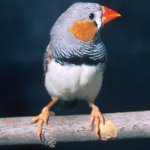Zebra Amadines
 Many people believe that the choice of domestic birdslimited canaries and a variety of parrots. But in fact at home you can keep other birds, for example, birds from the family of finch weavers. These include zebra amads.
Many people believe that the choice of domestic birdslimited canaries and a variety of parrots. But in fact at home you can keep other birds, for example, birds from the family of finch weavers. These include zebra amads.Zebra Amadines - one of the most popular weaver birds, bred by lovers. The homeland of these funny birds is Australia, but at the end of the 19th century they were brought to Europe and domesticated. They are quite unpretentious in content and food, live more than eight years and easily reproduce even at home (only if they are not hybrids).
These Small birds with a beautiful and bright appearance and a lively character will not leave anyone indifferent. Amadin males are more vigorous and colorized brighter than females. In domestic birds, the color is more "blurred" than in wild birds. Also, varieties of domestic amadines with other colorings were removed, but they are not very common in our country.
Having decided to get an amadine, remember that zebra amads are not attached to humans, as, for example, parrots. A cell with amadines is sometimes compared to a land aquarium: you can admire it, but you can not take it in your arms. But if you do not need a companion, and you just want to enjoy funny birds, zebra amadins are just what you need.
Zebra Amadins are completely independent and do not really need your company, so you can safely leave them at home only for a few days. The main thing is to leave them a feeder with enough feed and an automatic drinking bowl.
Please note that zebra amads are flocks of birds, so it is better to start a few birds at once. But to keep them is only together with their brethren in appearance: the amadin's temper is rather militant, therefore with other birds they can conflict. Although if the enclosure is quite spacious, zebra amadines can also get along with their neighbors.
But if you are going to keep only amadine, They do not need a large cell, because these birds are one and a half times less than the sparrow. The bottom of the cell should be sprinkled with washed river sand, as well as crushed activated charcoal (1 tablet) and grated chalk (small amount). The bathing and drinking bowl needs standard, not too large, so that the zebra amads are not drowned.
In nature, amadins feed on seeds and young shoots of wild grasses, as well as young insects. At home, they are quite suitable cereal mixture. Usually it includes canary and flaxseed, light millet varieties, etc. Well, if you have the opportunity to get a ready-made grain mixture for exotic species of birds. Forages for parrots, Amadin can not be fed!
In addition, zebra amadines need green fodder. In the winter it can be salad leaves and sprouted oats, and in summer it is possible to give field grasses collected far from roads and other sources of pollution. It is also recommended to include in the diet "mesh", Consisting of green food, grated carrots and boiled eggs. You can give steep, light-salted porridge, a little bit of white bread.
Also zebra amads are in need of source of calcium. You can buy special mineral mixtures, enriched with calcium, and you can instead give them a crumbled egg shell or shell rock.
Zebra Amadines breed well in captivity. If you want to get offspring from them, inMarch-April (mating period), you need to hang a wooden house with a hole in the cage and put some hay in it. If the conditions of feeding and keeping are correct, and the pair is matched successfully, the Amadins will build a nest in it.
The first eggs can appear in the nest only 3-4 days after the beginning of "courtship". If the birds do not sit on the masonry at once, do not panic.. Usually this happens after 3-4 eggs are in the nest. But if the amads do not sit on the masonry after 7-10 days, you need to remove the clutch together with the nest.
The chicks hatch about two weeks after the incubation begins. During the incubation and feeding of the chicks, it is necessary to provide the female with the maximum rest: do not make noise, do not make sudden movements, do not look into the nest. An alarmed female can stop incubating or stop feeding offspring.
At the age of three weeks the chicks begin to tryleave the nest, but if the attempt is successful, the chick may be unable to return. So he may need your help. But you can not touch the offspring without need - the feathered chicks are afraid of people instinctively, so acquaintance with you can turn into stress for the birds. Growing chicks must necessarily be discarded.
Note that zebra amads are capable of breeding already at the age of 2-3 months, but You can not let them nest before 6 months or even a year, and later than seven years. This can be dangerous for the health of the female, and the offspring may eventually prove to be unviable.
Zebra Amadines - beautiful and funny birds, ideal for those who can not pay too much attention to pets, but still wants to get some livestock at home.














